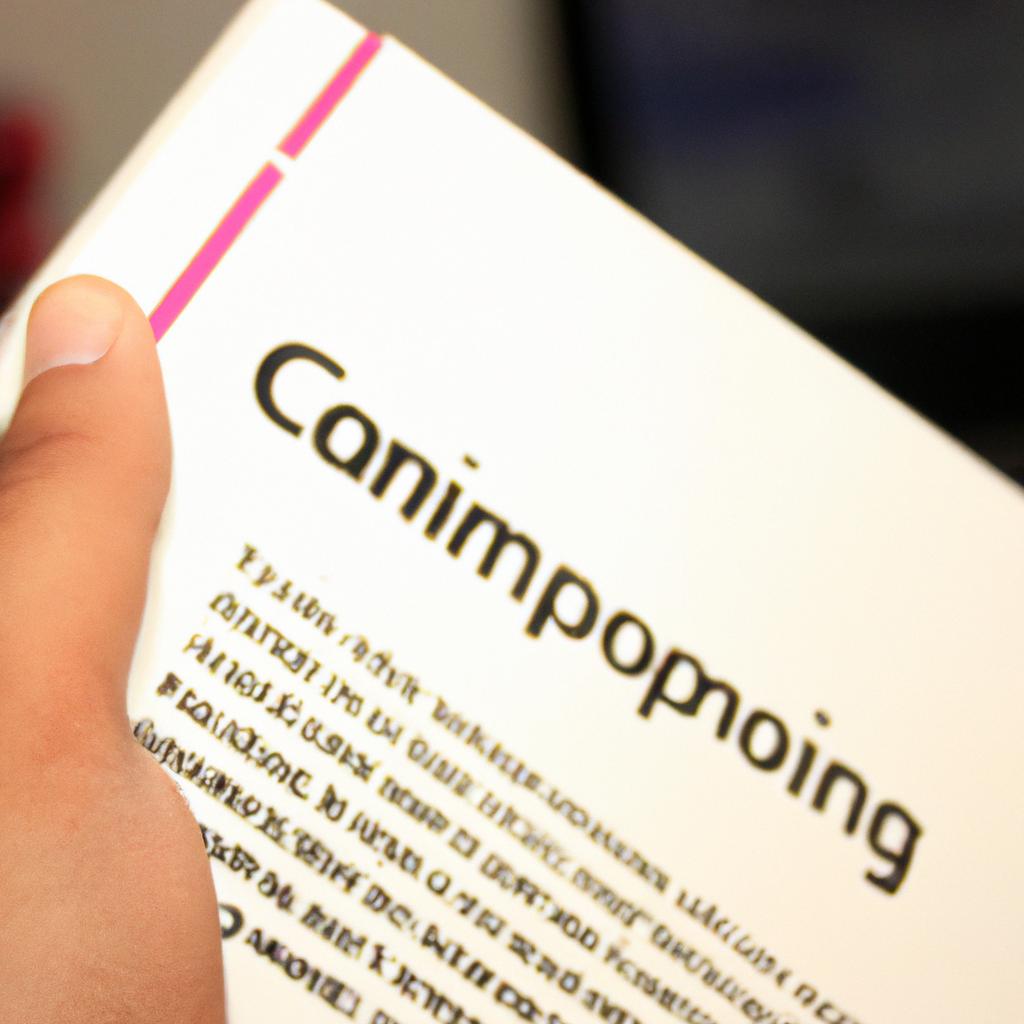Boolean: Data Types in Computer Programming Languages

Boolean data types are a fundamental aspect of computer programming languages, offering the ability to manipulate and analyze logical values. These data types, named after mathematician George Boole, allow programmers to represent two states: true or false. By employing boolean variables and expressions, developers can make decisions based on conditions and control program flow accordingly. For instance, consider a hypothetical scenario where a software application needs to determine whether a user is logged in or not before granting access to certain features. Boolean data types provide an efficient means of expressing and evaluating this condition.
In addition to their role in conditional statements, boolean data types also play a crucial part in various operations within computer programs. One prime example is the use of boolean logic operators such as AND, OR, and NOT. These operators enable programmers to combine multiple boolean expressions and evaluate them as a single result. This functionality allows for complex decision-making processes that involve multiple conditions simultaneously. Moreover, boolean data types serve as building blocks for more advanced concepts like loops and iterations, making them integral components of programming languages across different domains.
Overall, understanding boolean data types is essential for any programmer aiming to develop robust and efficient code. Through their utilization in conditional statements, logical operations, and other programming constructs, these data types facilitate effective problem-solving and decision-making in computer programming. By leveraging boolean data types, developers can create code that performs different actions based on specific conditions or combines multiple conditions to control program flow. This flexibility enhances the functionality and efficiency of software applications across various domains.
Boolean in computer programming languages
One of the fundamental concepts in computer programming is the Boolean data type. Named after mathematician and logician George Boole, this data type represents two possible values: true or false. While seemingly simple, Booleans play a crucial role in decision-making processes within programs.
To illustrate the significance of Booleans, consider a hypothetical scenario where an e-commerce website needs to determine whether a product is currently available for purchase. By using the Boolean data type, the program can assign the value “true” if the item is in stock or “false” if it is not. This information allows the website to display accurate availability statuses to its customers.
When discussing Boolean data types, several key characteristics come into focus:
- Simplicity: Booleans possess an inherent simplicity that makes them easy to understand and use.
- Efficiency: The binary nature of Boolean values (either true or false) enables efficient storage and manipulation of logical conditions.
- Decision-making: Booleans serve as essential tools when making decisions within code branches or loops.
- Logical operators: Programming languages provide various logical operators such as AND, OR, and NOT that work with Boolean values to create complex conditions.
| Logical Operator | Description |
|---|---|
| AND | Returns true only if both operands are true |
| OR | Returns true if at least one operand is true |
| NOT | Reverses the truth value of an operand |
In summary, understanding Boolean data types is pivotal in programming as they enable effective decision-making processes based on logical conditions. Their simplicity, efficiency, and compatibility with logical operators make them powerful tools for developers seeking precise control over their code’s behavior. In the following section, we will delve deeper into how programmers utilize Boolean data types through examples and practical applications.
Understanding Boolean data type
Understanding Boolean Data Type in Computer Programming Languages
Consider a scenario where you are developing a program to control the operation of an autonomous robotic vehicle. To ensure its smooth functioning, it is essential to incorporate decision-making capabilities within the code. This is where the Boolean data type comes into play. By representing logical values such as true or false, Boolean allows programmers to implement conditional statements and make informed choices based on specific conditions.
To delve deeper into the significance of the Boolean data type, let’s explore some key aspects:
-
Logical Operators: Boolean data types work hand-in-hand with logical operators like AND, OR, and NOT. These operators allow programmers to perform complex evaluations by combining multiple conditions seamlessly. For instance, when programming the navigation system for our robotic vehicle, we can use the AND operator to verify if both obstacle detection sensors indicate a clear path ahead before allowing forward movement.
-
Conditional Statements: Conditional statements form an integral part of any programming language. With Boolean variables and expressions, these statements enable developers to execute different blocks of code based on certain conditions’ evaluation results. In our case study, we might utilize an IF-ELSE statement that checks whether there is sufficient battery power remaining before initiating any further actions.
-
Decision Making: The flexibility offered by Boolean data types empowers programmers to create intelligent programs capable of making decisions autonomously. By evaluating various conditions and their corresponding outcomes using If-Else statements or Switch cases, software applications can adapt their behavior dynamically based on changing circumstances.
Now that we have established how crucial understanding the Boolean data type is in computer programming languages let us move towards exploring its practical applicability in real-world scenarios.
| Real-life Applications of | Table 1: Examples |
| Boolean Data Types | |
|---|---|
| Robotics | Controlling |
| Web Development | Conditional Rendering |
| Quality Assurance | Test case validation |
In summary, Boolean data types enable programmers to incorporate decision-making capabilities within computer programs. By leveraging logical operators and conditional statements, developers can create intelligent applications capable of adapting their behavior based on specific conditions. In the subsequent section, we will delve into real-world applications where the Boolean data type plays a pivotal role.
Applications of Boolean data type
Understanding Boolean Data Type
In the previous section, we explored the concept of the Boolean data type in computer programming languages. Now, let’s delve deeper into its applications and how it is used in various programming scenarios.
Imagine a scenario where you are developing a program to control an automated greenhouse system. The system relies on sensors to monitor temperature, humidity, and light levels inside the greenhouse. Based on these readings, certain actions need to be performed such as adjusting the ventilation or activating irrigation systems. In this case, the Boolean data type becomes invaluable as it allows us to represent conditions like “if temperature exceeds a certain threshold” or “if humidity drops below a specific level.”
The versatility of the Boolean data type extends beyond just controlling environmental systems. Let’s consider some other practical applications:
- Form validation: When users submit forms online, their inputs need to be validated before processing further. By utilizing Boolean variables, programmers can easily check if all required fields have been filled out correctly.
- Decision-making algorithms: Artificial intelligence often involves complex decision-making processes based on numerous factors. Using Boolean expressions enables these algorithms to evaluate different paths and make informed decisions accordingly.
- Game development: Games rely heavily on conditional statements for character movement, collision detection, scoring mechanisms, and more. Booleans allow developers to create interactive gameplay experiences by determining when certain events should occur.
To summarize our exploration of the applications of Boolean data types thus far:
| Applications | Description |
|---|---|
| Automated Systems | Controlling and monitoring various aspects of automated systems |
| Form Validation | Ensuring user input meets specified criteria |
| Decision-Making | Enabling intelligent decision-making algorithms |
| Game Development | Facilitating game mechanics such as character movement and event triggers |
As we continue our journey through understanding boolean data types in computer programming languages, the next section will focus on comparison operators and how they interact with the boolean data type. By exploring these operators, we can gain a deeper understanding of how to manipulate and evaluate Boolean expressions effectively.
[Transition] Let us now explore the fascinating world of comparison operators and their relationship with the Boolean data type.
Comparison operators and Boolean data type
Applications of Boolean Data Type
The Boolean data type, which represents the truth values “true” and “false,” has various applications in computer programming languages. One such application is in decision-making processes. For example, consider a program that controls access to a restricted area. By using Boolean variables, the program can determine whether an individual’s credentials are valid or not, leading to either granting or denying access.
Another common use of the Boolean data type is in conditional statements. These statements allow programmers to execute specific blocks of code based on certain conditions being met. For instance, a weather forecasting application may utilize Boolean variables to check if there is a high chance of rain before displaying a corresponding message to the user.
In addition to decision-making and conditional statements, Booleans also find utility when performing logical operations such as AND, OR, and NOT. These operations enable programmers to combine multiple conditions or invert their logic according to predefined rules. This versatility allows for complex evaluations and can help streamline code execution.
- The use of Booleans promotes efficient coding practices by providing clear representations of true/false states.
- Incorporating Booleans enhances readability and maintainability within programs.
- Proper utilization of Booleans reduces ambiguity and enables precise control flow.
- The simplicity and effectiveness of boolean operators contribute to robust error handling mechanisms.
| Advantages | Challenges | Considerations |
|---|---|---|
| Enhances code clarity | Potential nesting issues | Maintain consistent naming |
| Facilitates flow control | Complex logical expressions | Preserve intention |
| Promotes modular design | Overreliance on conditionals | Avoid excessive negation |
| Enables concise syntax | Handling default cases | Minimize cyclomatic complexity |
By leveraging the power of the Boolean data type in these ways, programmers can create more efficient, readable, and reliable software systems. In the following section about “Boolean expressions and logical operators,” we will explore how to combine Boolean variables with comparison operators to perform even more sophisticated operations.
Boolean expressions and logical operators
Comparison operators and the Boolean data type play a crucial role in computer programming languages. They allow programmers to evaluate conditions, make decisions, and control the flow of their programs. In this section, we will explore how boolean expressions are used with logical operators to create complex conditions.
Imagine you are building a program that manages an online store’s inventory. One important condition you need to check is whether a particular product is out of stock or not. To accomplish this, you can use comparison operators such as equal to (==) or not equal to (!=) along with the Boolean data type. For example, if the quantity of a specific product is greater than zero, it means the product is still available; otherwise, it is considered out of stock.
To understand boolean expressions better, let’s consider some common logical operators:
-
AND operator (
&&): Evaluates two boolean expressions and returnstrueonly if both expressions are true. -
OR operator (
||): Evaluates two boolean expressions and returnstrueif at least one expression is true. -
NOT operator (
!): Negates the value of a boolean expression. If the expression evaluates totrue, applying the NOT operator makes it false, and vice versa.
These logical operators enable programmers to build more complex conditions by combining multiple boolean expressions. By using parentheses for grouping and considering operator precedence rules (e.g., evaluating AND before OR), intricate decision-making processes can be implemented efficiently.
In summary, comparison operators help us compare values while Boolean data types represent either true or false. The combination of these concepts allows programmers to evaluate different conditions based on their requirements. In the next section about “Boolean in conditional statements,” we will delve into how booleans are utilized within conditional statements to further enhance program functionality.
Boolean in conditional statements
Boolean: Data Types in Computer Programming Languages
In the previous section, we explored boolean expressions and logical operators, which are fundamental concepts in computer programming languages. Now, let’s delve deeper into the usage of booleans within conditional statements.
To illustrate this further, consider a simple scenario where you have developed a program to determine whether a student has passed an exam based on their score. In this case, you would use a conditional statement that evaluates if the student’s score is above a certain threshold. If the condition is true (i.e., the student has passed), you can execute specific code or display a success message; otherwise, you can handle the failure accordingly.
Using boolean data types within conditional statements allows programmers to make decisions based on different criteria. Here are some key points to understand about using booleans in such scenarios:
- Boolean variables: You can declare and assign values to boolean variables that represent conditions or states. For example, you may have a variable named “isPassed” set to true when the student passes and false when they fail.
- Comparison operators: To evaluate conditions accurately, programmers often utilize comparison operators such as equality (==), inequality (!=), greater than (>), less than (<), etc. These operators allow for comparisons between values and return boolean results.
- Logical operators: By combining multiple conditions together, logical operators like “and,” “or,” and “not” enable more complex decision-making processes. For instance, you could check if both the score is above the passing threshold AND all required coursework is completed before considering someone eligible for graduation.
Now let’s take a look at how these concepts come together by examining a table depicting various outcomes based on two conditions: A (true/false) and B (true/false).
| A | B | Result |
|---|---|---|
| true | true | Passed |
| true | false | Failed |
| false | true | Failed |
| false | false | Failed |
In this table, we can see that the result is “Passed” only when both A and B are true. This demonstrates how boolean logic helps programmers make decisions based on specific conditions.
By understanding boolean data types and their utilization within conditional statements, programmers gain powerful tools to control program flow and respond dynamically to different situations. Whether it’s determining pass or fail outcomes for students or managing complex business rules in an application, booleans provide a foundational element of decision-making in computer programming languages.






